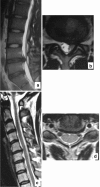Disc degeneration of cervical spine on MRI in patients with lumbar disc herniation: comparison study with asymptomatic volunteers
- PMID: 21127918
- PMCID: PMC3065617
- DOI: 10.1007/s00586-010-1644-y
Disc degeneration of cervical spine on MRI in patients with lumbar disc herniation: comparison study with asymptomatic volunteers
Abstract
An association between progression of cervical disc degeneration and that of lumbar disc degeneration has been considered to exist. To date, however, this association has not yet been adequately studied. Age-related changes in the cervical intervertebral discs were evaluated by magnetic resonance imaging (MRI) in patients with lumbar disc herniation, and compared with the MRI findings of healthy volunteers without lower back pain. The purpose of this study was to clarify whether the prevalence of asymptomatic cervical disc degeneration is higher in patients with lumbar disc herniation than in healthy volunteers. The study was conducted on 51 patients who were diagnosed as having lumbar disc herniation and underwent cervical spine MRI. The patients consisted of 34 males and 17 females ranging in age from 21-83 years (mean 46.9 ± 14.5 years) at the time of the study. The control group was composed of 113 healthy volunteers (70 males and 43 females) aged 24-77 years (mean 48.9 ± 14.7 years), without neck pain or low back pain. The percentage of subjects with degenerative changes in the cervical discs was 98.0% in the lumbar disc herniation group and 88.5% in the control group (p = 0.034). The presence of lumbar disc herniation was associated significantly with decrease in signal intensity of intervertebral disc and posterior disc protrusion in the cervical spine. None of the MRI findings was significantly associated with the gender, smoking, sports activities, or BMI. As compared to healthy volunteers, patients with lumbar disc herniation showed a higher prevalence of decrease in signal intensity of intervertebral disc and posterior disc protrusion on MRI of the cervical spine. The result of this study suggests that disc degeneration appears to be a systemic phenomenon.
Figures


References
-
- Aydogan M, Ozturk C, Mirzanli C, et al. Treatment approach in tandem (concurrent) cervical and lumbar spinal stenosis. Acta Orthop Belg. 2007;73:234–237. - PubMed
-
- Boden SD, McCowin PR, Davis DO, et al. Abnormal magnetic-resonance scans of the cervical spine in asymptomatic subjects. A prospective investigation. J Bone Joint Surg Am. 1990;72:1178–1184. - PubMed
Publication types
MeSH terms
LinkOut - more resources
Full Text Sources
Medical
Research Materials

